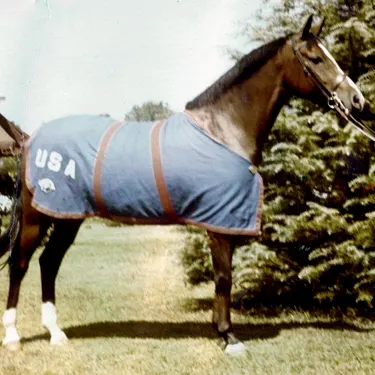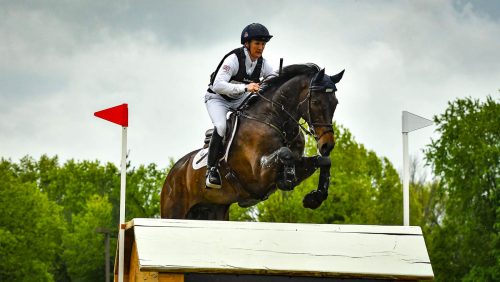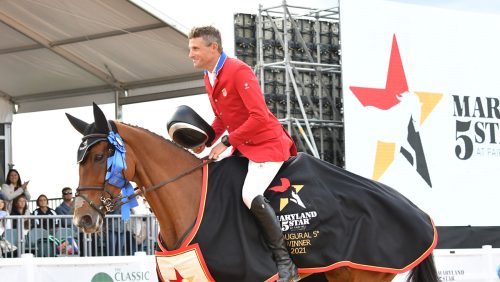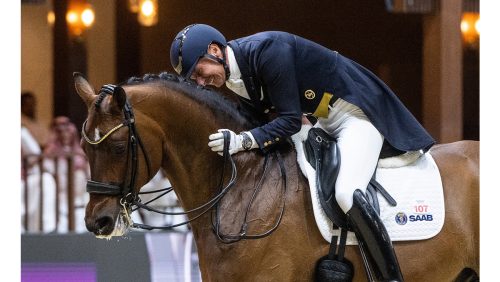Before the U.S. Pony Finals started and became many child’s yearly highlight, there was the International Pony Team Competition that had small and large pony teams from the United States competing against teams from England or Canada.
It all started back in 1959 when the British National Pony Society and the British Show Pony Society issued a challenge to the American Horse Shows Association for a team competition.
The first competition was held that November at Madison Square Garden during the Saturday evening performance of the National Horse Show. First there was the model section and then the under-saddle portion. The third section asked for the ponies to execute a figure eight at both the trot and the canter, jump two jumps, and then hand-gallop, halt, and back four steps.
Two jumps were all that they were asked to jump because normally the British ponies concentrated on their flatwork and did not jump. The model and under-saddle sections each counted 40 percent and the jumping counted 20 percent.
The Americans were ill-prepared. They had no previous training to compete as a team. On the other hand, the British were very prepared and beat the Americans. One highlight though was that the American team was led into the ring for the presentations by Hugh Wiley on Nautical, one of the winningest horses on the U.S. Equestrian Team.
The International Trophy that had been donated by Adrian Van Sinderen, Chairman of the American Horse Shows Association, was presented to the British team in front of a full house of American spectators at the Garden and made a trip across the Atlantic to England, where it would reside for the next two years.
In the November 23, 1959 issue of Sports Illustrated, Alice Higgins reported, “This event, perhaps the dreariest ever offered at the Garden, pitted a non-uniformed crew of American youngsters riding what, by contrast, appeared to be poorly-trained ponies, against a spit-dressed and dressage-polished pony team from England.”
The second competition was to be held in England in August of 1961. This time, the Americans were ready for what lay ahead. Tryouts for the teams were held at the Devon showgrounds in July.
From those tryouts, six small and six large ponies were invited to train for two weeks with noted horseman and instructor Gordon Wright at Gladstone, home of the USET. From those 12 ponies, eight would be selected to fly to England to compete against the British at the British Timken Horse Show in the second International Pony Team Competition.
While at Gladstone, the ponies were stabled in the same stalls that the USET horses were normally stabled and the riders stayed at the home of team chaperone Louise Coffin. They trained daily under the tutelage of Mr. Wright, with the occasional visit by USET Chef d’Equipe Bertalan de Nemethy. In their down time, the riders were treated to pool parties, dinners, and all sorts of fun activities.
After the two weeks of training, a final team of four small and four large ponies were selected to fly to England. The small team was Frank Owens on his Fancy, Susie Burr on her Wizard Of Oz, Skip Brittle on Coed Coch Llwydrew (owned by Mrs. C. C. Jadwin and Mrs. William C. Cox), and Frankie Gardiner on Gremlin’s Delight (owned by Mr. and Mrs. M. Kenneth Taylor).
The large team was Terry Rudd on her Hot Shot Kid, Betsy Firey on Honeydew (owned by Mrs. Graham Boyce), Roddy Wanamaker on Cathy (owned by George Widener Dixon), and Kathleen Watson on Farnley Kohlrabi (owned by Mr. and Mrs. M. Kenneth Taylor & Farnley Farm). Marguerite Taylor was selected to oversee the ponies while in England. The grooms selected were four A-rated Pony Club members including Bernie Traurig and David Hopper.
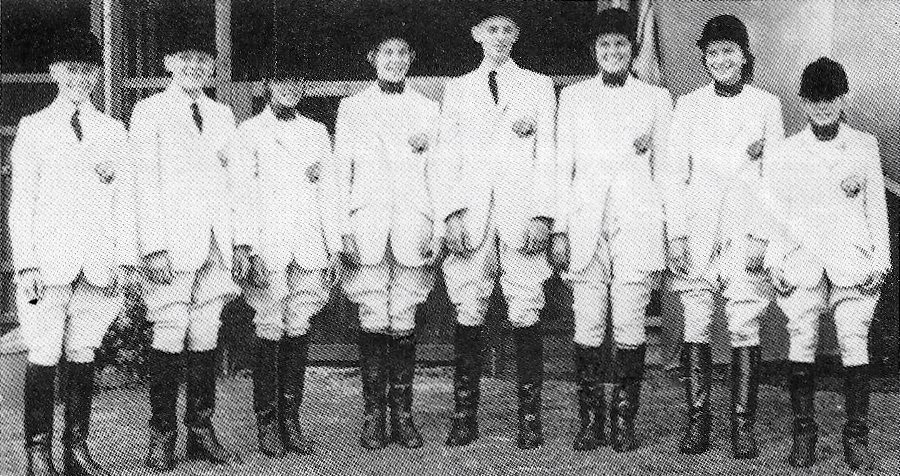
The 1961 American riders. From left to right: Skip Brittle, Frank Owens, Frankie Gardiner, Susie Burr, Roddy Wanamaker, Kathleen Watson, Betsy Firey (captain), and Terry Rudd.
When the ponies were in transit, first on a van from Hennessy’s and then on a Lufthansa plane, they wore white bandages with white cotton underneath, head bumpers, and a surcingle with tail guard. James Blackwell (Executive Director of the AHSA), Mrs. Taylor, Mr. Wright, Mr. Brittle, and the four grooms flew with the ponies. Mrs. Coffin flew on a commercial plane with the riders.

George Hennessy disinfecting the feet of Gremlin’s Delight, with Marguerite Taylor holding, at La Guardia airport before flying to England.
This time, unlike 1959, the American teams of ponies and riders were properly trained and turned-out for a team competition through the generosity of more than 100 donors and the full support of the AHSA and USET. Top saddler Dave Wright, of M. J. Knoud’s, donated custom sewn-in full bridles, sheets, blankets, and halters for each of the ponies while Paul Mayo of Paul’s Saddlery donated Eton blue linen coats with the AHSA insignia on the chest pockets, yellow breeches, black hunt caps, white shirts, plus navy blue ties and chokers for the riders.
George Hennessy, of Hennessy Horse Transportation, donated the shipping of the ponies from Gladstone to La Guardia airport (N.Y.) to fly to England and then their return trip, also. The USET lent their tackroom drapes and setup to the pony team.

Louise Coffin and the American riders on the steps of the plane that they were to fly to England.
ADVERTISEMENT
The Queen of England graciously permitted the American ponies to be stabled at Windsor Forest Stud, near Ascot Racecourse. The Queen’s representative, Major General D. Dawnay, saw to it that the Americans had everything that they needed and even gave the team a chance to gallop down the stretch at Ascot. The ponies loved this freedom to gallop so much that two of the riders got bucked off.
The British left no stone unturned when it came to entertaining the American team and their entourage including a trip to the Queen’s stable, a tour of Windsor Castle, a night of theater, and a trip to the Madame Tussauds Wax Museum.
The 1961 International Pony Team Competition was held on Aug. 25 at British Timken Arena. The judges were Mrs. John McDonald of the USA, Major K.P. Wallis of Great Britain, and Miss Iris Kellett of Ireland. When it was all said and done, the American team had won back the Van Sinderen Trophy. The Duchess Of Norfolk presented it to team captain, Betsy Firey.
About the experience of being on the 1961 Pony Team, Frank Owens said, “It was unbelievable. We were all just kids but it felt like we were going to the Olympics.”
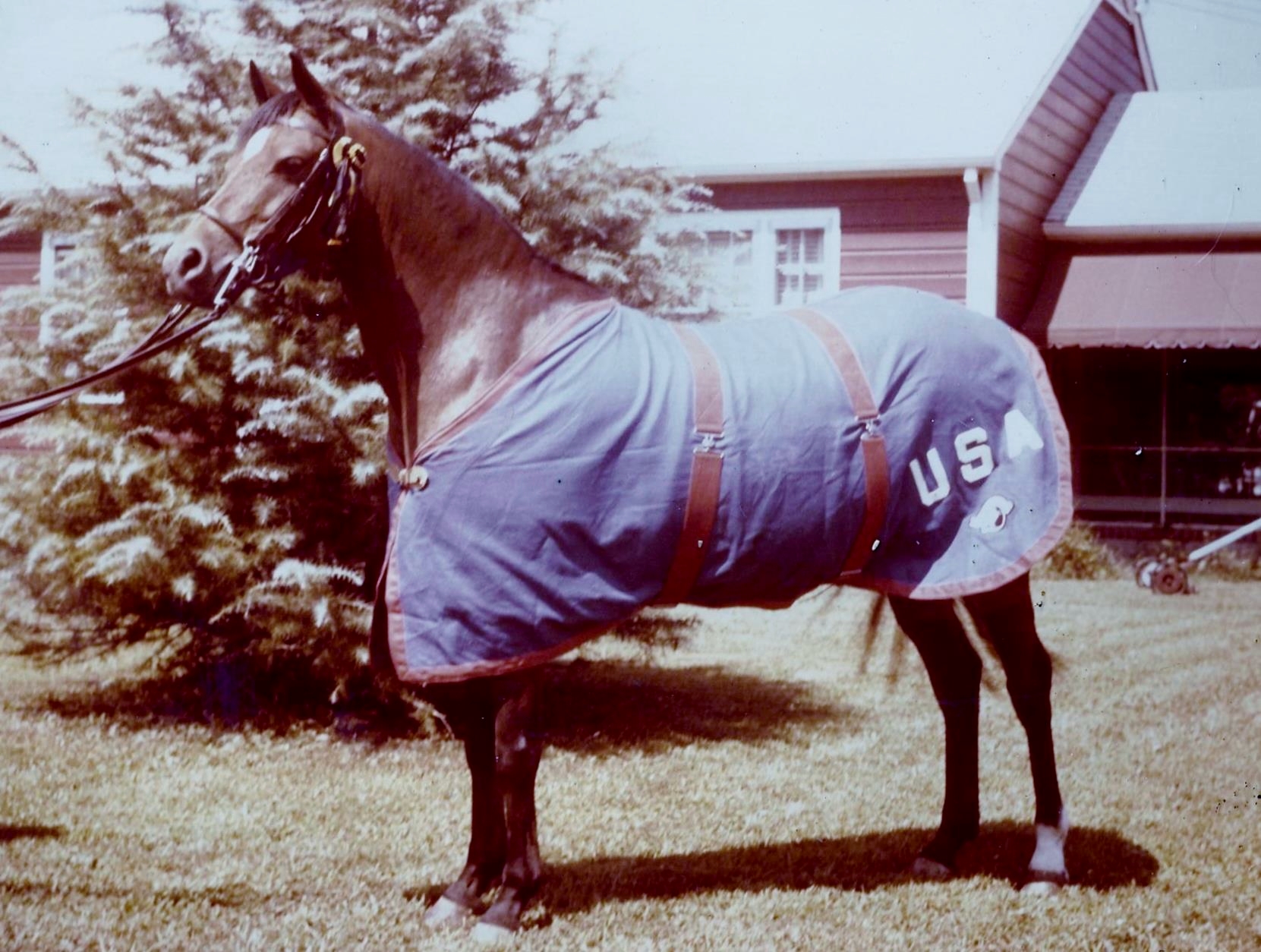
Gremlin’s Delight wearing her USA sheet, sewn-in full bridle, and ribbon won for winning the jumping portion with a perfect score.
As 1963 approached, the British pony societies decided that it was too costly to send another pony team back to the United States so an invitation was extended to Canada. They gladly accepted. The competition was to be held at the Fairfield Hunt Club (Conn.) on Aug. 24.
This time, I was able to try out on my small pony, Swamp Fox. I was 9 at the time.
Once again, the tryouts were held at the Devon showgrounds in July and the turnout was massive. Besides Swamp Fox with me riding, my parents also owned Johnny Reb that Bill Graves was riding. Bill was too large on Johnny Reb but Johnny was tough and not just anyone could ride him.
Both of our ponies made the initial team that went for training with Gordon Wright. We were to report to Fairfield Hunt Club on Sunday, August 18th, along with ten other pony/rider combinations.
We arrived at Fairfield and took care of the ponies before going to the hotel where the riders were staying. It was time for me to meet my roommate, Puddy Jones (also 9). My parents were staying at a different hotel but I was in good hands because our chaperones were Louise Coffin’s daughter, Susie, and 1961 Pony Team captain, Betsy Firey.
I also had Bill Graves looking after me like I was his little sister. Bill came to our room every night to make sure Puddy and I were alright and to tuck us in. It was greatly appreciated by the two youngest kids trying to make the final team.
Back in those days, we did all sorts of things with our show ponies—fox hunted, swam in the ocean, rode cross-country, played cowboys and Indians—but flatwork was not one of those things.
Monday morning came and we all had an awakening when our first lesson with Gordon Wright was working on extension, flexion, and those types of things. Our training continued like that all week.
We learned about making precise and even parts on each side of our figure eights and making the center line straight instead of actually making it look like an “8”. We learned about using a pulley-rein to stop our ponies quickly. Mr. Wright gave us valuable tools and lessons that week. All of which I continued to use many, many years later.
Our week wasn’t all work and no play. In the afternoons, we would swim in the pool at the hotel then have dinner at someone’s mansion on the Sound or at the Hunt Club.
The Canadians arrived late Wednesday night and from then on, they were included in all of our activities. On Thursday, we took a bus into New York City and did touristy stuff like go to the United Nations and go to the top of the Empire State Building. That night, we were invited to take a dinner cruise on a private yacht as it sailed around Manhattan.
On the bus back to Fairfield, we sang song after song. We were really coming together as a team as well as getting to know the Canadians.
On Friday morning, we tried out once again but this time judged only by Gordon Wright as he selected the final team to compete the next day against the Canadians. Mr. Wright paired ponies and riders together that he thought would be most likely to win the competition.
ADVERTISEMENT
Johnny Reb did not make the final cut but Bill Graves was put on a large pony because he was more experienced than the original rider. The final small team was Criban Dart with Nancy Burr, Severn Ducat with Tim Lawrence, Welland Valley Early Bird with Meta Boykin, and Swamp Fox with me riding.
The final large team was Highfield’s Tulip with Susie Blaisdell, Thorwell with Karen Lewis, Blue Moon with Beaver Tate, and Miles River Mist with Bill Graves.
After the final team was selected, we were presented with our new riding clothes from Paul’s which were just like the ones used in England in 1963. Once again, the USET had lent us their tackroom drapes and the ponies all wore the USA sheets at night.
The Pony Team Competition received national press with both the Associated Press and United Press International sending out stories. I even got a telegram from the mayor of my hometown wishing me good luck. I was so excited and proud! Saturday could not arrive fast enough.
When time came to mount our ponies and head to the Fairfield outside course to assemble for a pre-competition tour around the ring, from behind came the loud music of the Highland Pipe & Drum Corps.
Chaos ensued! Ponies scattered everywhere. It was very funny and any nerves that we felt were gone as we tried to calm our ponies.
The first classes judged were the small and large models. Then came the under saddles for both sections. After that, we had the individual performances where we entered the ring, saluted the judges, made a figure eight at both a trot and a canter, jumped four jumps around the outside, and then hand-galloped up the center of the ring, halted, and backed four steps. The teams were evenly matched so the tension was high as we waited for the results.
After a long wait, the team results were announced and a huge roar of applause came from the crowd as the United States was named the overall winner. We were led into the ring by bagpipes and although most ponies were better this time with the loud noise, Swamp Fox (who was normally very quiet and pokey) proceeded to take off with me and to lap the other ponies.

The Van Sinderen trophy
I soon got him stopped (using my newly-learned pulley-rein). Both teams lined up in the center of the ring while American team captain, Tim Lawrence, was presented with the Van Sinderen Trophy and the National Anthem played. Even at the age of 9, hearing that song while lined up with my team is a feeling that I will never forget.
We then did a victory lap and headed back to the barns. It was a day like none other in my life.
The final results were..
Small Ponies
1. Trefesgob Lagus – Cathy Logan CAN 228 points
2. Severn Ducat – Tim Lawrence USA 220½ points
3. Welland Valley Early Bird – Meta Boykin USA 206½ points
4. Swamp Fox – Marianne Taylor USA 205 points
Large Ponies
1. Highfield’s Tulip – Susie Blaisdell USA 243 points
2. Criban Atlanta Of Catherson – John Atack CAN 230 points
3. Little Sheba – Cathy Macdonald CAN 228 points
4. Thorwell – Karen Lewis USA 222 points
Unfortunately, countries could not bear the expenses of holding or fielding teams for International Pony Team Competitions after 1963 but those of us that were on either the 1961 or 1963 team had experiences that we will never forget. I can think of nothing in my junior years that meant as much to me as being on the 1963 American Pony Team.
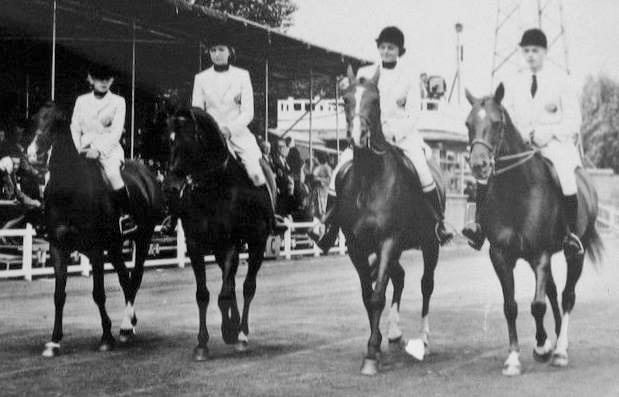
The 1961 American team of large ponies. From left to right: Terry Rudd on her Hot Shot Kid, Betsy Firey on Honey Dew owned by Mrs. W. Graham Boyce, Kathleen Watson on Farnley Kohlrabi owned by Mr. & Mrs. M. Kenneth Taylor and Farnley Farm, Roddy Wanamaker on Cathy owned by George Widener Dixon.

The 1961 American team of Small Ponies. From left to right: Susie Burr on her Wizard Of Oz, Frankie Gardiner on Gremlin’s Delight owned by Mr. & Mrs. M. Kenneth Taylor, Frank Owens on his Fancy, and Skip Brittle on Coed Coch Llwydrew owned by Mrs. William C. Cox and Mrs. C.C. Jadwin.

